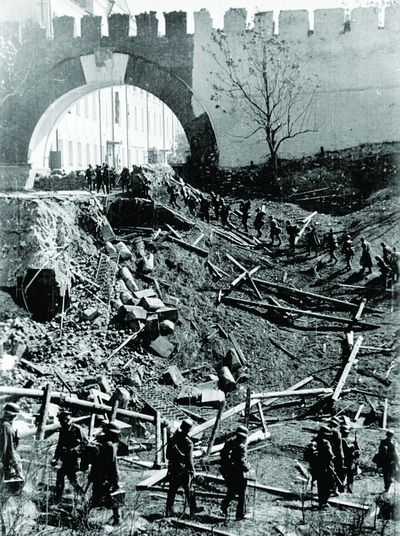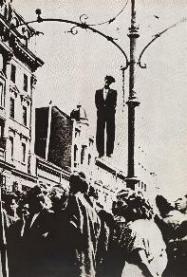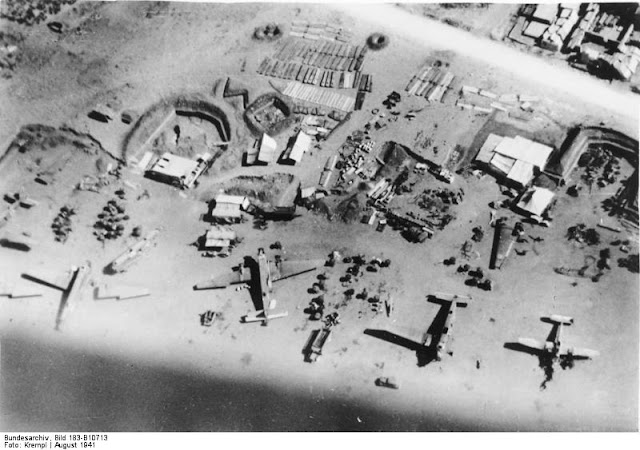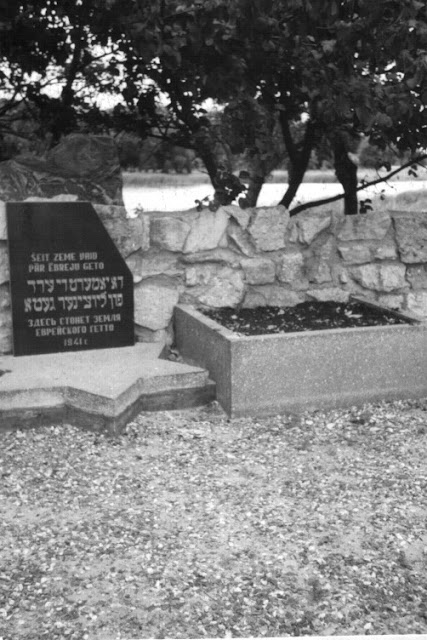Sunday 17 August 1941
 |
| German troops entering the Kremlin of Novgorod, 17 August 1941 (Federal Archive, Bild 183-H26513). |
Eastern Front: The Wehrmacht on
17 August 1941 continues to hold the initiative, but every day more trucks break down and more men get killed and more tanks need new tracks and engines and other maintenance. Generalleutnant Wolfgang Fischer at the 10th Panzer Division headquarters notes in the war diary that there are no spare parts available, and when trucks break down, the choice either is to leave them or to tow them.
In the Far North sector, the Finnish 18th Division crosses the Vuoksi River and establishes a secure bridgehead. Other Finnish forces continue putting pressure on trapped Soviet troops throughout the Karelian Isthmus. For most of them, the only possibility of escape is by boat across Lake Ladoga.
 |
| Infantry support gun (7.5 cm light infantry gun) of the German 291st Infantry Division on the firing position near the Narva River, on or about 17 August 1941. |
In the Army Group North sector, the Germans take Narva, Estonia, and 56th Panzer Corps of Panzer Group 4 strengthens its grip on Novgorod. The Wehrmacht is busy transferring three divisions from Army Group Center to Army Group North, but Field Marshal von Bock at the former is resisting releasing one of the motorized divisions because of the ongoing Soviet offensive south of Lake Ilmen.
In the Army Group Center sector, General Guderian's Panzer Group 2 continues driving toward Bryansk, while 2nd Army advances on Gomel. The Soviets continue attacking the exposed German "lightning rod" position at Yelnya, but the Germans are holding fast. Field Marshal von Bock calls off an offensive planned against Mozir. Halder talks with von Bock during the day, and the latter remains fixated on the possibility of renewing the attack on Moscow as soon as possible. Meanwhile, the Soviet 24th Army attacks a German bridgehead at El'nia.
In the Army Group South sector, the Romanian 4th Army scores a major success by capturing the water supplies of Odessa. The Soviets are under strict orders to hold the city for as long as possible, an order underscored by Stalin's Order No. 270 issued on the 16th which prescribes death for anyone who exhibits dereliction of duty. The Romanians still have not made a real assault on the city, however.
The Soviets are retreating in the vicinity of Dnepropetrovsk, which the German Panzer Group 1 captures. The Luftwaffe sends fighter-bombers from I. and II./JG 3 along with III./JG 52 against the city. The Luftwaffe pilots claim to shoot down 33 Soviet planes, including 29 bombers. The Soviets complete their evacuation from Nikolayev, covering their final withdrawal with 8 destroyers of the Black Sea Fleet. The Germans also take Nikopol on the Dneiper.
 |
| Home Guard troops practice defending a roadblock with smoke and rifle fire, 17 August 1941. |
European Air Operations: Today's RAF missions are distinguished by few losses. However, the results of the missions are mediocre, so not much is accomplished by either side. All in all, it is a fairly unremarkable day in the air.
During the day, the RAF sends 20 Blenheims on the usual coastal sweeps. These include all three major types of aerial operations: Circus, Roadstead, and Rhubarb operations. Some shipping is attacked off Terschelling. All of the aircraft return safely.
After dark, the RAF continues its series of heavy attacks on German. Tonight's targets are Bremen and Duisburg.
The RAF puts 39 Hampdens and 20 Whitleys over Bremen. The targets are the Focke-Wulf factory and railways yards. The Germans shoot down two Hampdens. The RAF pilots claim hits on the airplane factory.
The RAF puts 41 Wellingtons over the Duisburg railway yards, with all of the planes returning. Not much is accomplished on this raid because the weather prevents accurate aiming.
Also during the night, a dozen Hampdens also lay mines off of Denmark, a Wellington raids Dunkirk, and 6 bombers go on training missions over Europe. No losses on these missions.
Battle of the Baltic: Soviet submarine Shch-307 hits a mine and sinks near Suursaari Island (Gogland).
German torpedo boat S.58 sinks Soviet minesweeper/patrol boat No. 80 in the Gulf of Finland.
German auxiliary minesweeper M-1707 hits a mine and sinks in the Gulf of Finland.
Soviet patrol boats attack a German convoy in the Gulf of Finland off Cape Domesnas. They cause the ships to engage in evasive maneuvers, during which German minesweeper M.1707 "Luneburg" comes under fire from Soviet coastal artillery, which causes Luneburg to engage in more evasive maneuvers. The end result is that Luneburg blunders into a German minefield off Arensburg, Ösel Island and strikes a mine, and sinks.
Estonian submarines Kalev (Lt. Cmdr. Nyrov) and Lembit (Lt. Cmdr. Poleschuk) lay mines off Bornholm.
Soviet submarine ShCh-216 is commissioned.
Battle of the Atlantic: Royal Navy submarine HMS Tigris torpedoes and sinks 1482-ton Norwegian freighter Haakon Jarl off Svaerholt, Norway in the Barents Sea. There are three deaths.
The Luftwaffe bombs and damages 1999-ton British freighter Kindersley a few miles off Blyth. Kindersley makes it to the Blyth on the 18th.
The Luftwaffe attacks Convoy WN-68 off Aberdeen but scores no hits.
In Operation Kedgreree (part of Operation Ration), the Royal Navy sends ships to sea to intercept what is believed to be a Vichy French convoy carrying contraband destined for Germany. There is a similar mission in the Indian Ocean by cruisers HMS Hawkins and HMAS Australia, with the same code names. Neither of these operations spots any French ships.
A Luftwaffe Focke-Wulf Fw-200 Condor of I,/KG 40 spots Convoy OG-71 and radios the location to BdU in Paris. The Kriegsmarine vectors in U-201 (ObltzS Adalbert Schee), which shadows the convoy.
Spanish freighter Navemar departs from Lisbon bound for Cuba and New York. The ship is overcrowded with 1800 refugees, mainly Jews fleeing Hitler, and conditions are terrible. The ship acquires the nickname "the floating concentration camp."
Convoy WS-10 arrives at Freetown
 |
| Group photos of some Royal Marines aboard either HMS Neptune or HMS Kandahar, 17 August 1941. These men all lost their lives later in the year when their ship hit a mine and sank. (Neptune Association). |
Battle of the Mediterranean: Dutch submarine O-23, operating in the Sicilian Strait, attacks an Italian convoy sailing from Naples to Tripoli. O-23 torpedoes and badly damages 5479-ton Italian freighter Maddalena Odero. The freighter, escorted by Italian torpedo boats Pegaso and Sirtori, heads for Lampedusa. The RAF (Bristol Blenheim aircraft of No. 105 Squadron) later attacks Maddalena Odero twice, setting its cargo on fire. Maddalena Odero is written off on the 18th.
Tonight's Tobruk run is made by Royal Navy destroyers HMS Kipling and Nizam. The British land supplies and rotate in some Polish troops, then make it back to Alexandria without incident.
Royal Navy submarine Regent is damaged at the dock in Alexandria when one of its own torpedoes explodes. Nobody is injured, but the submarine is damaged.
At Malta, RAF Hurricanes shoot down a Caproni seaplane east of Zonqor Point. RAF No. 800 Squadron Swordfish attack the Italian convoy that O-23 also attacks, claiming hits on three ships, but only the hits on Maddalena Odero are confirmed. Three Hurricanes attack seaplanes in Syracuse harbor, claiming hits on several targets.
Battle of the Pacific: German raider Komet (AMC Schiff 45), operating southeast of the Galapagos Islands, captures 7322-ton Dutch freighter Kota Nopan. The cargo includes valuable commodities including 2800 tons of sago, 1500 tons of rubber, 1200 tons of tin, and 1200 tons of manganese. The Germans put a prize crew on the ship and send it to France (where it arrives safely in November). This is Komet's second success in the area in recent days after a long quiet period in the vastness of the Pacific.
 |
| Public hanging in Belgrade, 17 August 1941 (Muzej Revolucije Narodnosti Jugoslavije). |
Spy Stuff: German agent Juan Pujol Garcia, who has been sent to London via Lisbon, instead is camping out in Lisbon and only pretending to be in London. His mission is to recruit British spies - in London. Today, from Lisbon, he radios his handler, Friedrich Knappe-Ratey aka "Frederico," and claims that he has successfully recruited a local agent. At this time, Garcia is not yet working as a double-agent - he is simply making up believable nonsense and reporting it as fact.
Partisans: The Germans stage a public hanging on Terazije in Belgrade. This is becoming a standard punishment for suspected partisans and terrorists.
Tito, who has led the partisan movement in Yugoslavia, begins to coordinate his partisan activities with Moscow (Comintern).
 |
| The repair workshop on Maleme airfield, Crete, where the dozens of Luftwaffe transport planes damaged during Operation Mercury are being repaired (Krempl, Federal Archive, Bild 183-B10713). |
US/Japanese Relations: With President Roosevelt back in Washington following the Atlantic Conference, Secretary of State Cordell Hull brings Japanese Ambassador Nomura in to see him. This is the fourth meeting between Roosevelt and Nomura. Responding to Nomura's request for a summit meeting between Roosevelt and the leader of the Japanese government, Prince Konoye, Roosevelt says he requires a clear statement of Japan's intentions in the Pacific. Roosevelt says that the US, Britain, and the Soviet Union wished for peace for in the Pacific, but few others did (a veiled reference to the Tripartite powers).
Roosevelt seems open to a summit meeting with Konoye. However, he says it cannot be in Hawaii because "I am not permitted to travel in an airplane." He proposes that Konoye come to Juneau, Alaska, Seattle, Washington, or San Francisco. Nomura casually mentions that such a meeting would best be held by mid-September.
Anglo/US/Chinese Relations: The Nationalist Chinese government in Chungking indicates its approval of the Atlantic Charter - though everybody in Asia is scratching their heads about its implications for the region. A common interpretation is that the Americans have refused to go along with British attempts to drag the United States into the war and thus may be more accommodating to the Japanese than previously thought.
 |
| Benigno Aquino Sr. (4th from left) with President Manuel L. Quezon, August 17, 1941. |
Soviet Military: Admiral Vladimir Tributs is put in charge of the defense of Leningrad.
Japanese Military: The Imperial Japanese Navy continues requisitioning merchant ships for use in various roles within the navy. Today, those include:
- 6486-ton freighter Kenyo Maru
- 7158-ton Sanuki Maru
- 17,526-ton liner Kamakura Maru
The IJN converts the Snauki Maru into a seaplane tender, mounting two 150-mm/45 cal single-mount guns, two 80-mm single-mount guns, two 13.2-mm single-mount machine guns, and a catapult. The IJN converts Kamakura Maru into a charter vessel for the Yokosuka Naval District.
British Government: Foreign Secretary Anthony Eden submits a report to the War Cabinet on the current state of morale in Italy. The report finds that Italian civilian and military morale has plummeted during the war and that many Italians dislike the Germans and like the British. The reports cautions, however, that:
The chances of knocking Italy out of the war (ie forcing her to a separate peace) can now be discounted since the Germans would certainly forestall any such move in Italy by converting the present moral occupation into a physical occupation of the country. But the more depressed and restless the Italians become the less effective is the Fascist Government’s contribution to the German effort, and the greater do Germany’s policing responsibilities in Italy become.
The report concludes:
The moral of this is that, even though we cannot now hope to knock Italy out, we should not relax efforts to hit metropolitan Italy by air and from the sea whenever opportunity offers. Each blow against Italy is a blow against Germany.
The RAF based at Malta has been bombing Rome, Milan, and Naples, but overall it has not suffered nearly as much from Allied bombing as has Germany.
Australia: The government approves the formation of the Australian Women’s Army Service (AWAS).
 |
| Memorial to the Ludza Massacre of 17 August 1941 (Find a Grave). |
Holocaust: From now until 27 August, the Jews of Ludza, Latvia, about 800 people, are taken 7 km out of town. There, they are marched into two long pits, shot, and buried.
 |
| Walt Disney, wife Lillian, and his party arrive in Rio de Janeiro, 17 August 1941. |
American Homefront: Walt Disney begins a goodwill tour of Latin America. Accompanying Walt on the trip, which is underwritten by a $70,000 government grant, is his wife Lillian and studio personnel Mary Blair, Frank Thomas, Bill Cottrell, Ted Sears, and a dozen other animators. Flying Pan American Airways, the group arrives today in Rio de Janeiro. This is the beginning of a 10-week journey. Thomas later recreates the trip in the documentary "Walt and El Grupo." Thomas credits the trip with enhancing Mary Blair's skills - she becomes one of the most renowned artists, animators, and illustrators in Disney history.
Future History: John Wesley Powell is born in Lakeland, Florida. As "Boog" Powell, he becomes a Major League baseball player best known for his years on the Baltimore Orioles. He wins the American League Most Valuable Player award in 1970 and plays on championship teams in Baltimore in 1966 and 1970. Boog Powell retires in 1977. Boog later explains that "Boog" is a shortening of "bugger," an affectionate nickname for children in the South.
Fritz Wepper is born in Munich, Germany. He becomes a well-known German actor in the late 1950s and plays Inspector Harry Klein in the crime series "Derrick."
Francesco Columbu is born in Ollolai, Sardinia. He becomes a renowned bodybuilder who wins Mr. Olympia in 1976 and 1981. He alternates titles with Arnold Schwarzenegger, who wins the 1980 Mr. Olympia, and the two become friends, with Columbu serving as Schwarzenegger's best man during his marriage to Maria Shriver. Columbu generally is considered to be Schwarzenegger's most famous contemporaneous bodybuilding competitor. Like Schwarzenegger, Columbu branches out into acting, appearing in movies such as "Conan the Barbarian" (1982) and "Ancient Warriors" (2003), as well as television shows and commercials. Schwarzenegger appoints Columbu to the California Board of Chiropractic Examiners, where he serves from February 2006 to January 2014.
Gabriella Farinon is born in Oderzo, Italy. Farinon becomes an actress in films such as "Space-Men" (1960) and a prominent television presenter on Italian television public broadcasting company RAI. She remains active throughout the 1960s-1990s and apparently is retired as of this writing in 2018.
 |
| Wesel, Brückstraße, Altstadt. In the background Willibrordi Cathedral (Proietti, Ugo, Federal Archive, Bild 212-291) |
August 1941
August 1, 1941: More Executions on CreteAugust 2, 1941: Uman Encirclement ClosesAugust 3, 1941: Bishop von Galen Denounces EuthanasiaAugust 4, 1941: Hitler at the FrontAugust 5, 1941: Soviets Surrender at Smolensk August 6, 1941: U-Boats in the ArcticAugust 7, 1941: Soviets Bomb BerlinAugust 8, 1941: Uman Pocket CapturedAugust 9, 1941: Atlantic Conference at Placentia BayAugust 10, 1941: Soviet Bombers Mauled Over BerlinAugust 11, 1941: Rita Hayworth in LifeAugust 12, 1941: Atlantic Charter AnnouncedAugust 13, 1941: The Soybean CarAugust 14, 1941: The Anders Army FormedAugust 15, 1941: Himmler at MinskAugust 16, 1941: Stalin's Order No. 270August 17, 1941: Germans in NovgorodAugust 18, 1941: Lili MarleenAugust 19, 1941: Convoy OG-71 DestructionAugust 20, 1941: Siege of Leningrad BeginsAugust 21, 1941: Stalin EnragedAugust 22, 1941: Germans Take CherkassyAugust 23, 1941: Go to KievAugust 24, 1941: Finns Surround ViipuriAugust 25, 1941: Iran InvadedAugust 26, 1941: The Bridge Over the DesnaAugust 27, 1941: Soviets Evacuate TallinnAugust 28, 1941: Evacuating Soviets SavagedAugust 29, 1941: Finns take ViipuriAugust 30, 1941: Operation AcidAugust 31, 1941: Mannerheim Says No2020



















